�
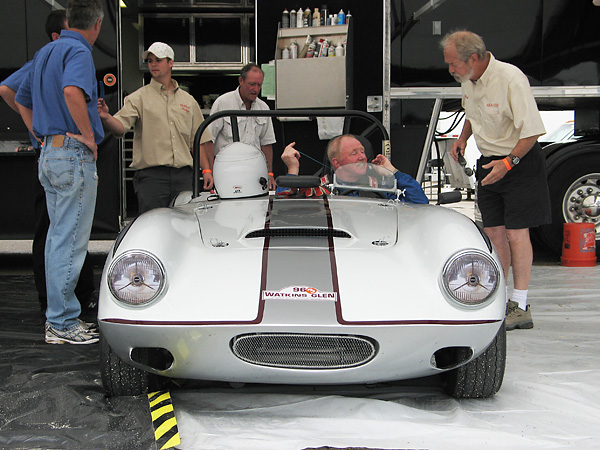
�
Bill Thumel's Elva Courier Race Car, Number 36
� Owner: Bill Thumel� City: Virginia Beach, VA
� Model: 1961 Elva Courier
� Prepared by: Abacus Racing, Virginia Beach VA�
�
History of the Elva Courier
��
Elva Engineering Company Ltd. started in a small garage in Bexhill on Sea, East Sussex �
in the early 1950's. The garage's proprietor was an ambitious young entrpreneur named �
Frank Nichols, who purchased a C.S.M. race car and was keen to improve and race it. �
The garage took whatever jobs they could to fund their racing aspirations. They also �
looked for performance products they could manufacture and sell. One of their earliest �
and most successful products was an aluminum, overhead-valve cylinder head for the �
Ford I.O.E. four cylinder engine family. Elva sold thousands of these cylinder heads.�
�
Elva Engineering was interested in all aspects of race car design and construction, so�
it was natural they should try their hand at producing cars from scratch. They built two �
complete race cars of their own design for the start of the 1955 season, and they �
immediately began taking orders for more. Before long, they were building multiple models �
including sports racers and formula junior cars, some of which were exported to the �
United States. No more than several dozen Elva race cars were produced before �
Elva Engineering began sketching a road going sports car. �
�
The first Elva Courier was built in 1958. It featured a very lightweight "semi-space frame" �
chassis with 3" round steel tubing for the main rails, combined with smaller tubes.�
A stylish prototype aluminum body was commissioned from the famous Williams & �
Pritchard Ltd. coachbuilding company. The aluminum prototype was used as a plug for �
creating initial molds; all serial production Couriers were built with fiberglass bodies.�
�
Only about fifty Mk1 Couriers were made. Most of them were powered by the early (1489cc) �
MGA engine. Another distinguishing feature of the Mk1 Courier is its two-piece windshield. �
The Mk2 Courier convertible was introduced in early 1961, and a coupe version followed �
soon after. The Mk2's single-pane, curved windshield was an obvious improvement. More �
important and subtle changes were made to the drivetrain, chassis, and suspension. �
The newer (1588cc) MGA engine provided more power. A new frame design provided more �
comfortable and usable room inside the car, and the Mk2 Courier also featured a coil �
spring rear suspension.�
�
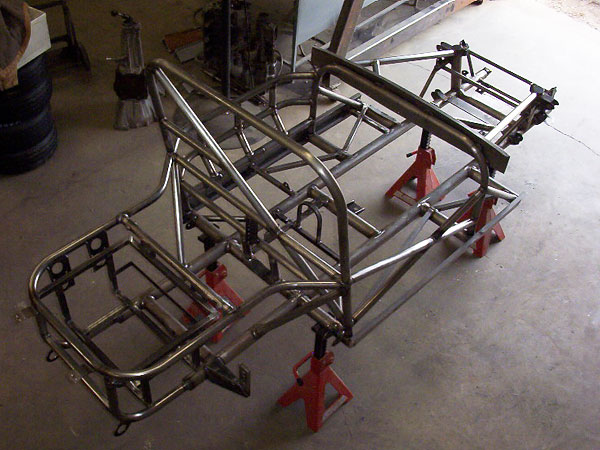
�
Elva Courier replacement chassis, reinforced for racing, as fabricated by
�
James Bowler of Weldone Inc. in Richmond Virginia.
�
�
Export to the U.S. market would define the beginning and end of Elva Engineering's �
production of Couriers. An initial order for thirty cars arrived like a �
gift from U.S. importer Walter Dickson. With Dickson as the sole initial "customer", �
the young company would be able to secure financing and to work out supply and production �
issues. A small factory was built in nearby Hastings, and the company staffed up to an �
ultimate high of about 65 employees. Approximately 400 cars later (including kits for �
home market customers who wished to avoid Britian's purchase tax on new cars), that �
same U.S. importer wrote a bad check and put Elva into liquidation. �
�
�
Enjoying this article? www.BritishRaceCar.com is partially funded through generous support from readers like you!
�
To contribute to our operating budget, please click here and follow the instructions.
�
(Suggested contribution is twenty bucks per year. Feel free to give more!)�
�
Trojan Limited bought the rights to the Courier in 1962 and moved production to their�
own factory. With high hopes for increased sales volume, the Courier chassis design �
was changed to utilize box-tubing and Triumph Vitesse front suspension components �
including optional disc brakes. Most Mk3 Couriers were powered by the latest (1622cc)�
MGA engines. With the Mk4 Courier, introduced in October 1963, even more powerful �
(1798cc) MGB engines and independent rear suspensions became standard equipment. �
Despite all this development, Courier sales failed to grow, and Trojan's production �
of Couriers only came to about 210 cars.�
�
In 1965, ownership and production of the Courier model was again transferred. Customized �
Sports Car Company (operated by a gentleman named Ken Sheppard) built about forty more �
Elva Couriers. �
�

�
�
�
No one would claim that the Elva Courier was a commercial success - in total, less than �
700 Couriers were ever built - but the model's success as a race car is a different �
story. In 1960's sports car racing, Courier's were a favorite alternative for those who �
wanted something appreciably lighter than an M.G. or Triumph. Probably the most famous �
Courier driver was a young Mark Donahue, who campaigned his Courier quite successfully �
throughout the mid-Atlantic states. Couriers were driven to many victories and several �
SCCA championships. �
�
Want to go racing in an Elva Courier today? They're getting pretty scarce. The good �
news is that the Courier was designed from day one to be produced in low volume and �
with simple tools, so it's entirely feasible for a skilled fabricator to replicate �
any Courier-specific part, or even to build a Courier from scratch.�
�
Because a variety of engines and displacements were original to Couriers, these cars �
can be set up to suit a variety of competition classes. Spares and performance upgrades �
for the M.G. engines are particularly readily available and inexpensive. Relatively �
easy to maintain and tune, Couriers can be exceptionally competitive within the classes�
they fit. The continued popularity of Couriers in vintage racing is guaranteed by�
all these factors. �
�
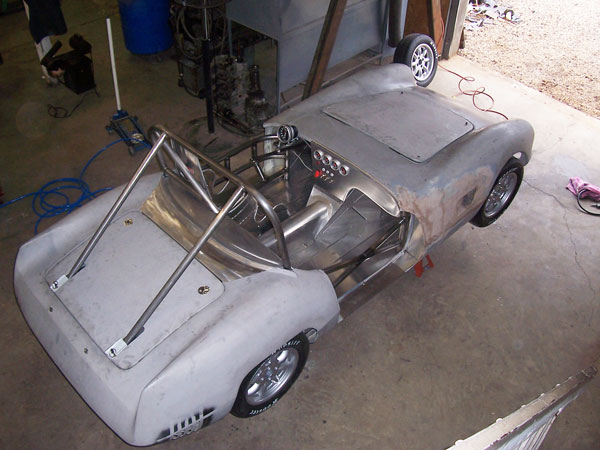
�
�
Bill Thumel's Elva Courier
��
Bill Thumel purchased his Elva Courier in Gaithersburg, Maryland. The Maryland title�
showed that that the car had been registered as a 1961 model, and the car's chassis plate �
was stamped "100-17-L". The SCCA log book showed that it had begun its racing career �
in 1962, and that it had mostly competed at local tracks, especially the old Marlboro �
Motor Raceway (which closed in 1969, shortly after Summit Point opened).�
�
But the old car was in rough shape. It had been parked a long time, and had sunken �
into the mud. Parts of the frame were severely rusted, but the car was basically complete, �
including an MGA 1.5L engine. The frame would need to be replaced. The body would need �
so many patches that it would have been quite heavy, so molds for a new fiberglass body �
were made by laying fiberglass over the original body. Original wheel uprights and �
steering rack were retained. Abacus Racing built up the engine, installed it, and completed �
all the performance engine and chassis tuning. �
Please support the sponsoring companies who make www.BritishRaceCar.com possible, including:
� �
 �
�
�
�
Features and Specifications
�| Engine: | �1798cc BMC B-series with HRG-Derrington 7-port crossflow aluminum cylinder head. �
Approximately 12:1 static compression ratio. Dual Weber 45DCOE carburetors. �
ATI Super Damper degreed harmonic balancer. Mallory Unilite distributor. �
MSD6AL capacitive discharge ignitiono with Blaster 2 coil and Taylor Spiro Pro �
8mm ignition leads. Stock Car Products "Super Flow" oil pump (wet sump) and �
stock MGB oil cooler. Accusump oil reservoir. | �
| Cooling: | �Griffin aluminum radiator, with a Spal electric fan. | �
| Exhaust: | �custom 3-into-2-into-1 step-up header. | �
| Transmission: | �Quaife Engineering Ford "Rocket" heavy duty, dog ring, 4-speed gearbox with �
alloy maincase. Tilton clutch. | �
| Rear Axle: | �Currie Enterprises Ford 8" rear axle with limited slip differential. | �
| Front Susp.: | �custom independent suspension featuring custom fabricated unequal/unparallel A-arms,�
Alford & Alder (Triumph Herald) forged uprights and MG Midget hubs.�
Aluminum-bodied QA1 coilover shock absorbers (5" stroke).�
Elva proprietory steering rack. | �
| Rear Susp.: | �custom 3-link. | �
| Brakes: | �(master) Tilton pedal assembly with bias bar. Residual pressure valves. � (front) Wilwood calipers and vented rotors. Wilwood blue, 2psi residual pressure valve. � (rear) Ford drum brakes. Wilwood red, 10psi residual pressure valve. | �
| Wheels/Tires: | �Compomotive 6J14 / Hoosier 205/60D14. | �
| Electrical: | �a lightweight, racing alternator has been mounted off the rear axle. Optima battery. | �
| Instruments: | �AutoMeter Sport-Comp tachometer (0-10,000rpm),�
oil pressure (0-100psi), �
oil temperature (140-280F),�
coolant temperature (100-250F),�
voltmeter (0-18V). | �
| Fuel System: | �Fuel Safe fuel cell. Holley "Red" fuel pump. Fram HPG1 fuel filter. �
Holley fuel pressure regulator. | �
| Safety Eqmt: | �Kirkey 39-series seat. Simpson 5-point harness with Cam Lok closure. �
Racetech steering wheel with Allstar Performance quick release hub. �
Safecraft fire suppression system. | �
| Weight: | �1523#, measured without fuel or driver. Approximately 51/49 weight distribution.�
(Note: class rules require the car weigh at least 1378#, plus a 100# weight penalty�
for using a Derrington cylinder head and a 20# weight penalty for removal of �
the passenger seat.) | �
| Racing Class: | �SVRA 3CP | �
Building the Chassis
�� Note: these construction photos were taken by James Bowler at his shop in Richmond Virginia.�
��
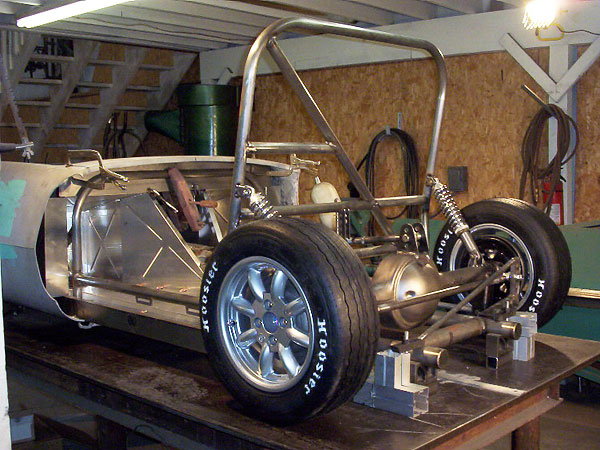
�
�
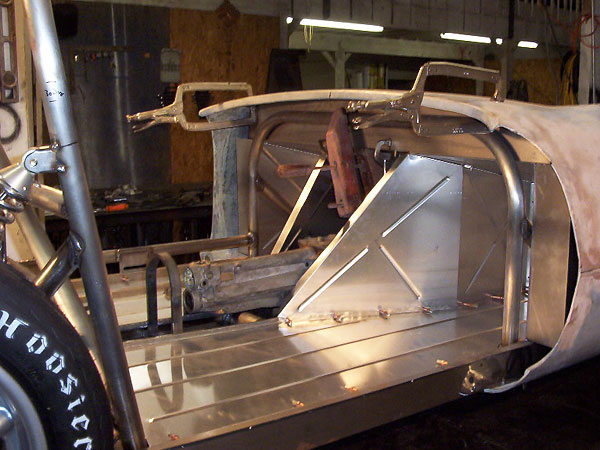
�
�
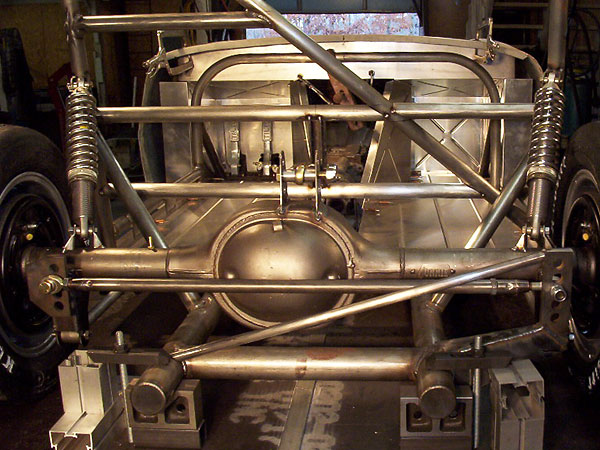
�
�

�
�
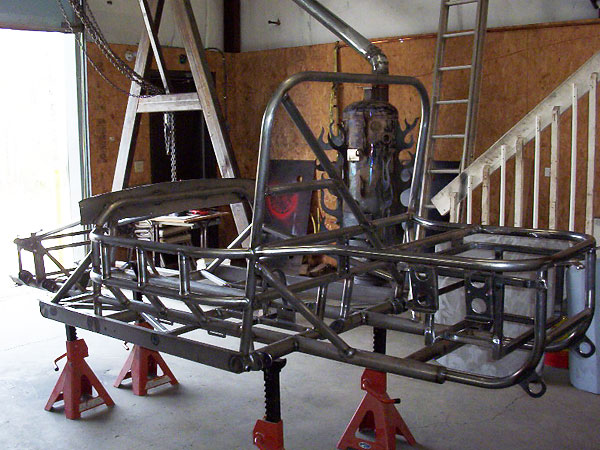
�
�
Please support the sponsoring companies who make www.BritishRaceCar.com possible, including:
�
 �
�
�

�
�

�
�

�
�
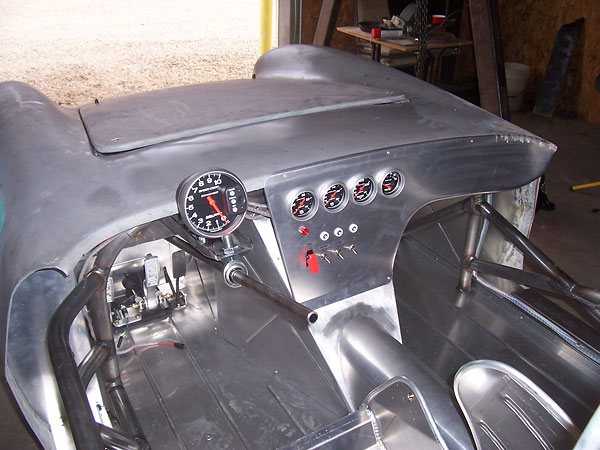
�
�
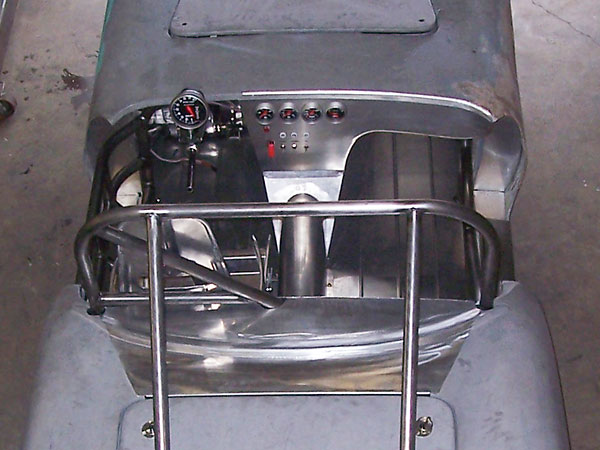
�
�

�
�
�
Suspension and Brakes
�� Note: these construction photos were taken in February 2009 at Bill's shop: Abacus Racing in Virginia � Beach. They actually show a second, sister car that was under construction at that time. There are some� variances between the two cars, but generally they're being built to similar specifications.�
��

�
Elva Courier front suspension. Note: Hank Giffin's 1959 Elva Courier MkII (1.6L) can be seen at right.
�

�
Wilwood brake calipers.
�
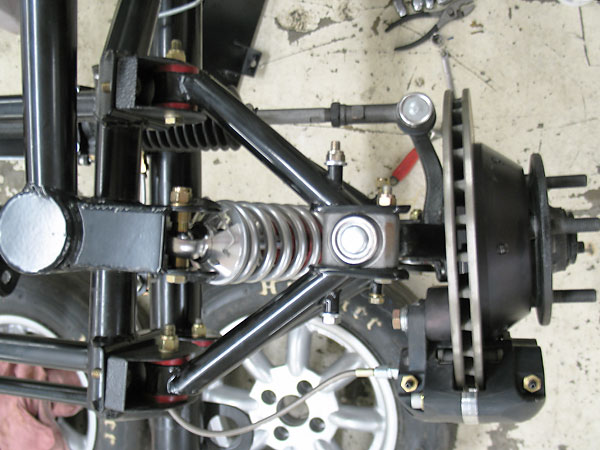
�
Custom suspension featuring unequal/unparallel A-arms, coilover shocks, and Triumph GT6 uprights.
�
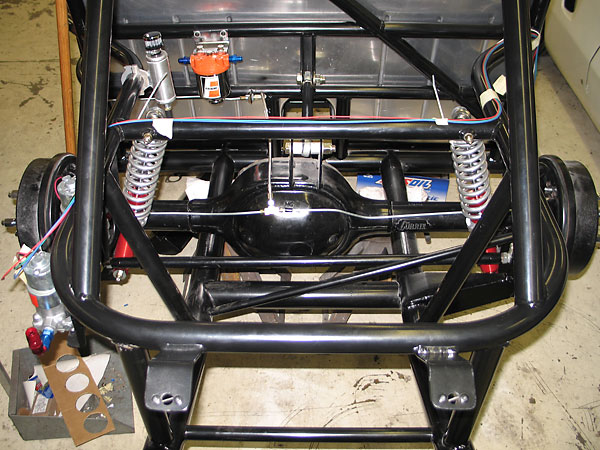
�
Currie Enterprises Ford 8" rear axle. (Note: rear shock absorbers are mounted differently on this car.)
�

�
Three-link rear suspension.
�

�
Panhard rod.
�
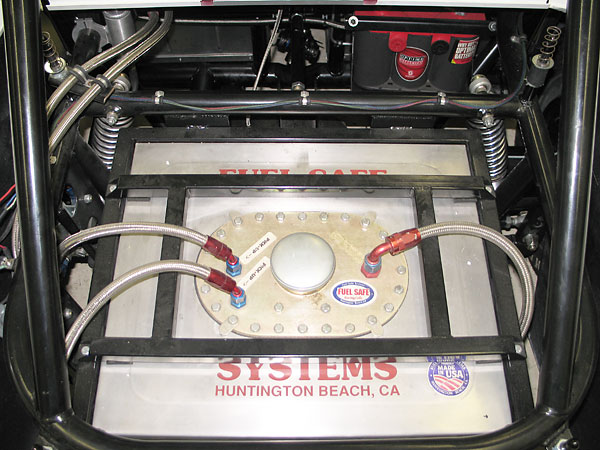
�
Fuel Safe Systems, Huntington Beach CA.
�
Engine Installation
��

�
1798cc BMC B-series with HRG-Derrington 7-port crossflow aluminum cylinder head.
�
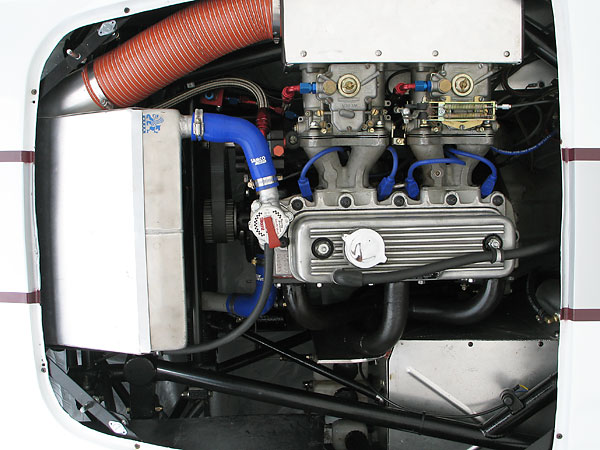
�
The front of the cylinder head is stamped "CT697, 205/5/59".
�
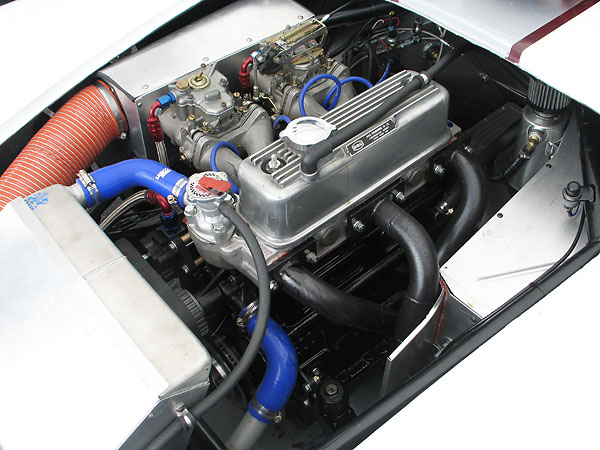
�
Custom 3-into-2-into-1 step-up header.
�
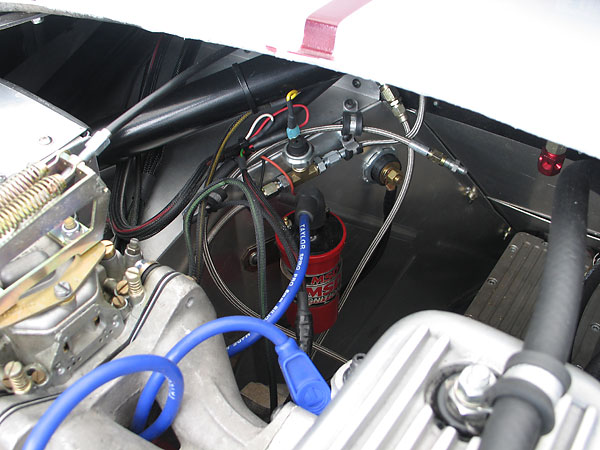
�
MSD6AL with Blaster 2 coil and Taylor Spiro Pro 8mm ignition leads.
�

�
Quaife Engineering Ford "Rocket" heavy duty, dog ring, 4-speed gearbox with alloy maincase. Tilton clutch.
�
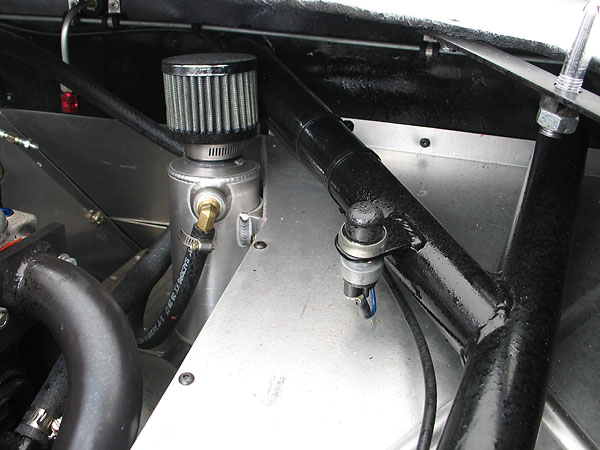
�
Foreground: remote starter switch. Background: breather tank.
�

�
Tilton pedal assembly with bias bar.
�
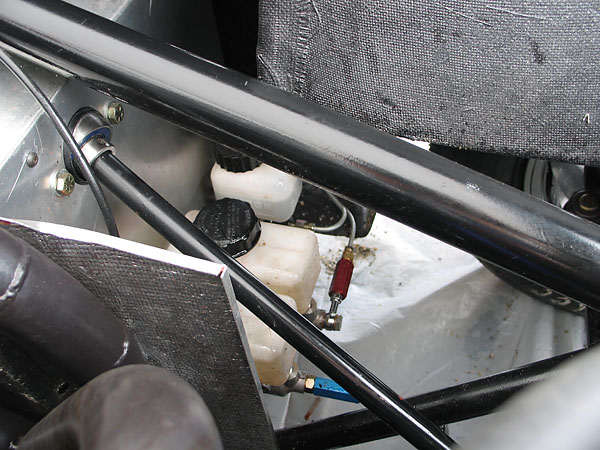
�
Wilwood residual pressure valves. (Blue/2psi for front disc brakes, red/10psi for rear drum brakes.)
�
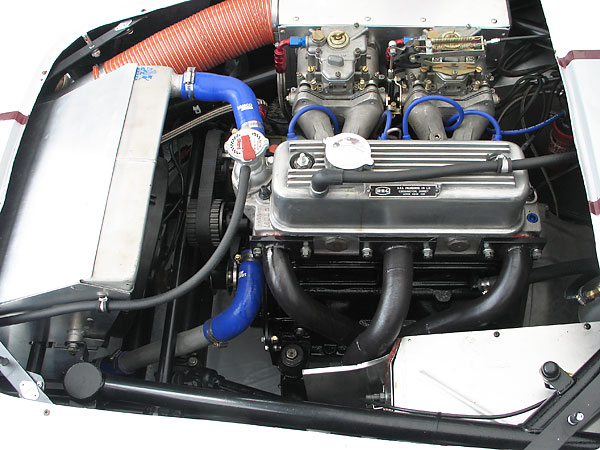
�
The valve cover is badged "HRG Engineering Co. Ltd., Chessington, Surrey, Lower Hook, 4149".
�
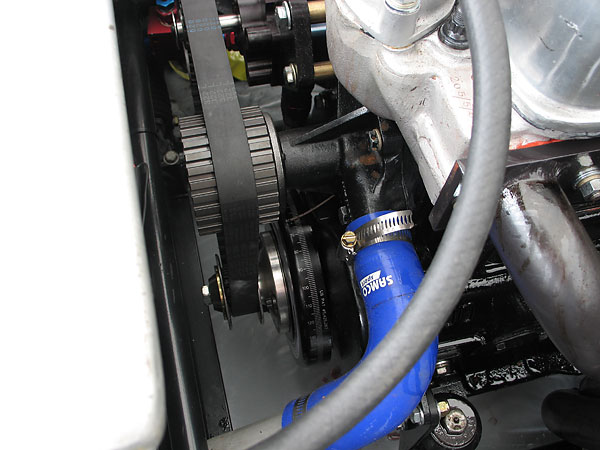
�
ATI Super Damper degreed harmonic balancer.
�

�
Griffin aluminum radiator, with a Spal electric fan.
�
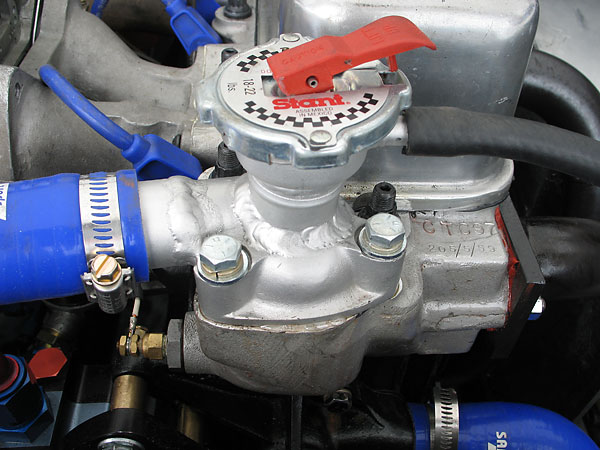
�
Stant 18-22psi pressure cap.
�
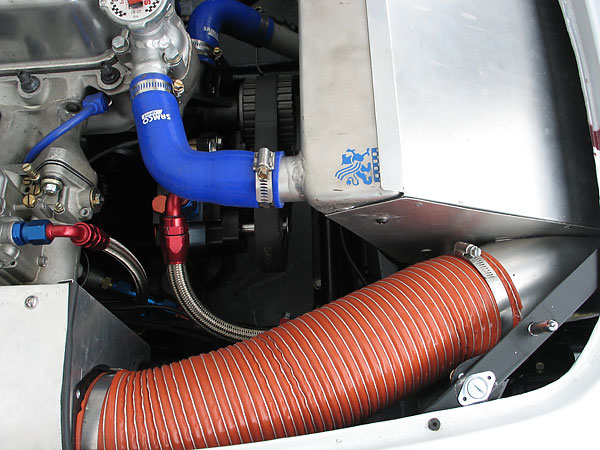
�
Cold air induction hose.
�

�
Stock Car Products "Super Flow" oil pump (wet sump).
�
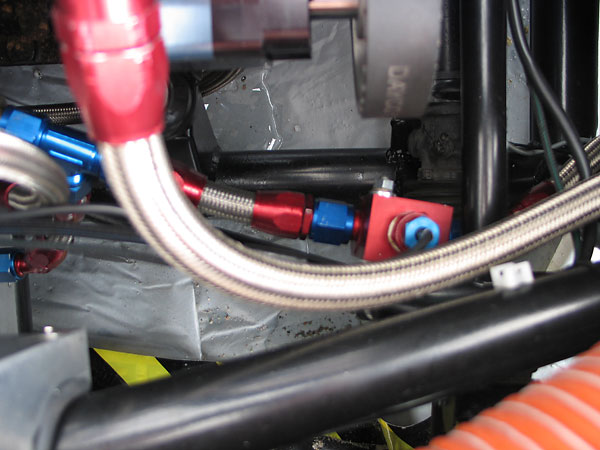
�
�

�
Fuel pressure regulator and remote oil filter.
�
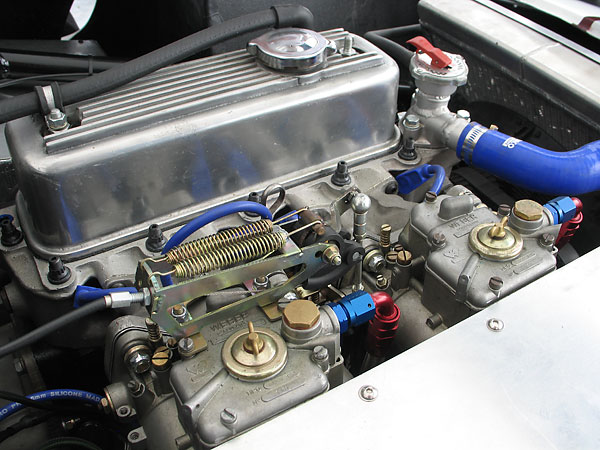
�
Dual Weber 45DCOE carburetors.
�
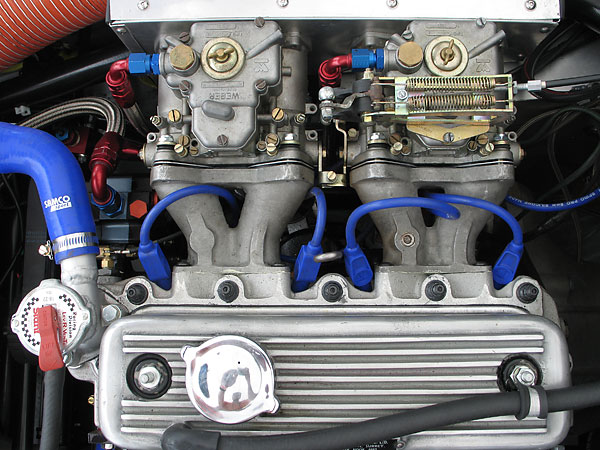
�
(Intake manifolds.)
�
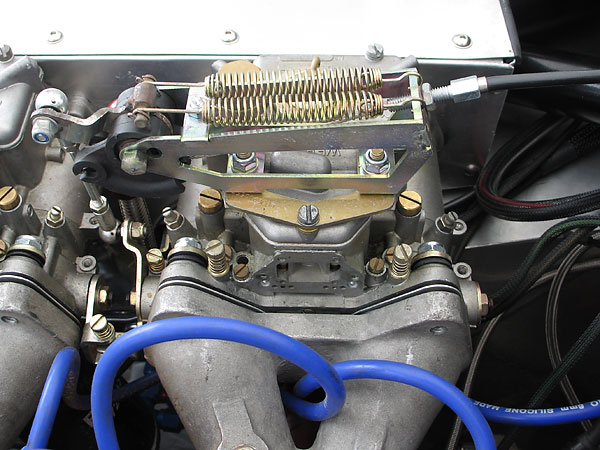
�
(Throttle linkage.)
�

�
The carburetors are stamped "Made in Italy, Tipo 45DCQE152, Number 1331".
�
�
Interior
��
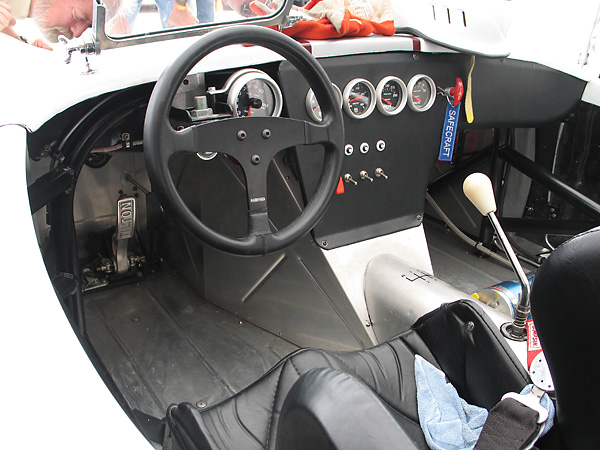
�
Racetech steering wheel.
�
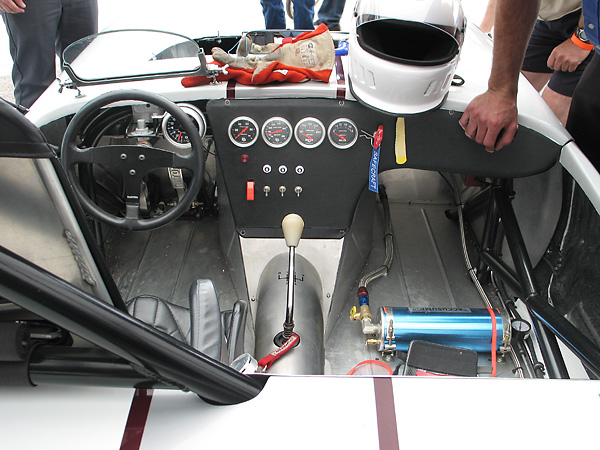
�
�

�
AutoMeter Sport-Comp tachometer (0-10,000rpm)...
�
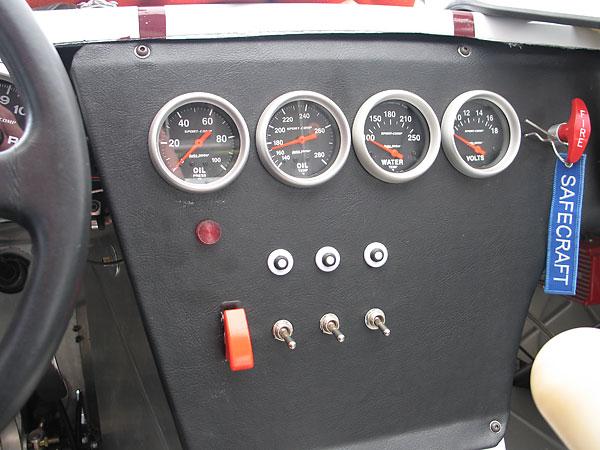
�
...oil pressure (0-100psi), oil temperature (140-280F), coolant temperature (100-250F), voltmeter (0-18V).
�
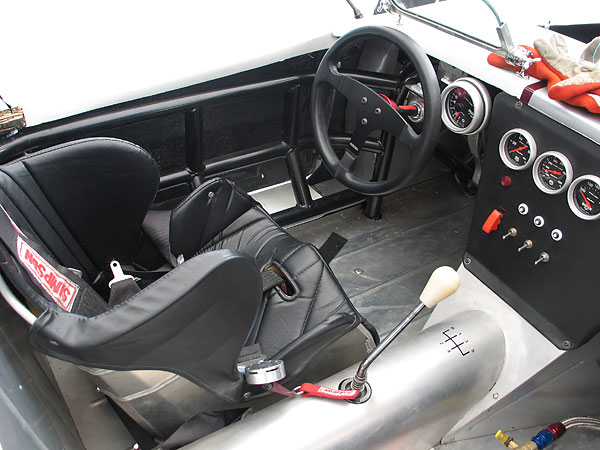
�
Kirkey 39-series seat.
�

�
Simpson 5-point harness with Cam Lok closure.
�

�
Tilton brake pedal assembly with bias bar.
�
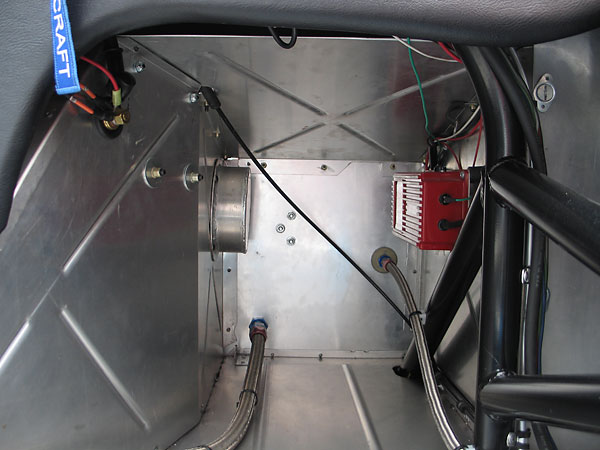
�
MSD6AL capacitive discharge ignition module.
�
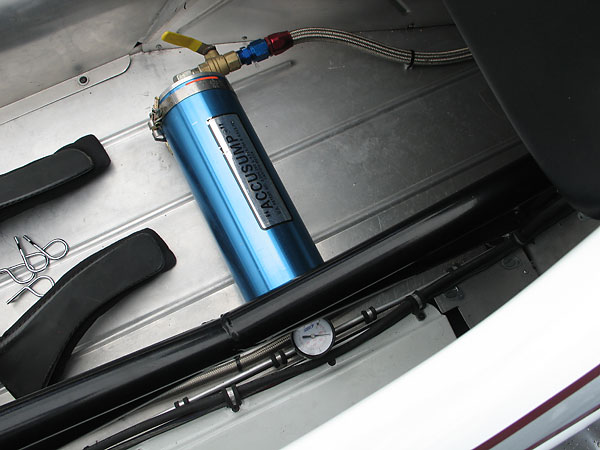
�
Accusump.
�

�
Door latch.
�
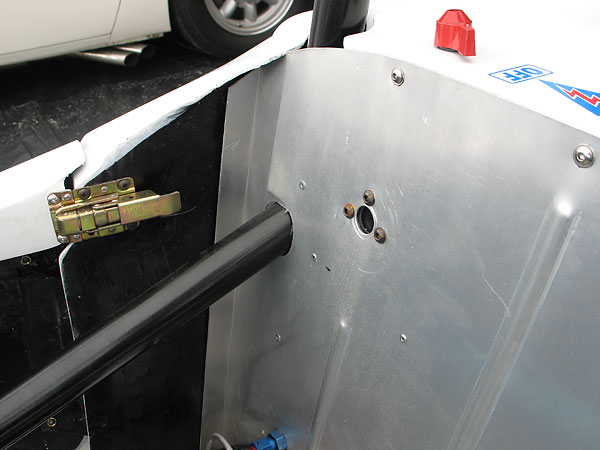
�
�
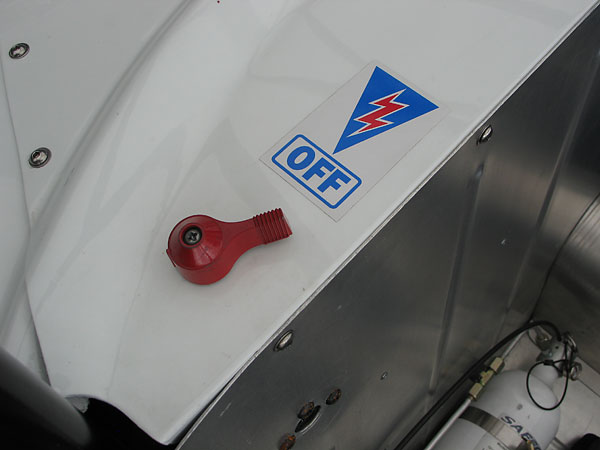
�
Kill switch.
�
�
Exterior
��
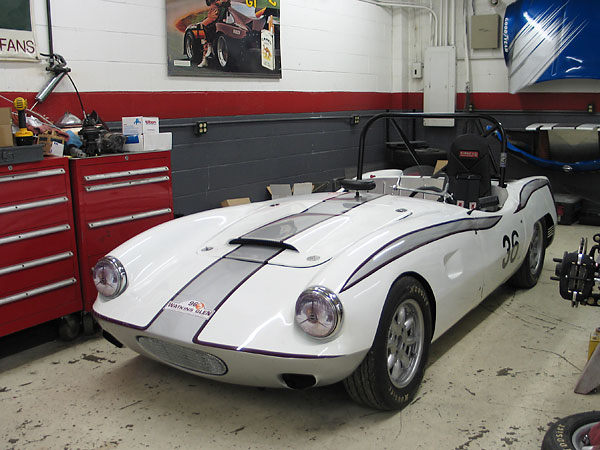
�
�
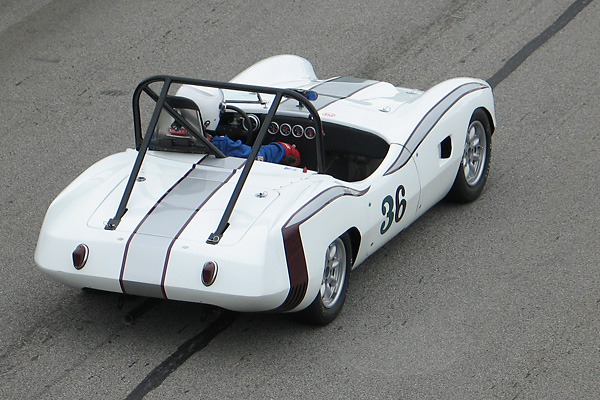
�
Bill Thumel's Elva Courier Race Car, Number 36
�
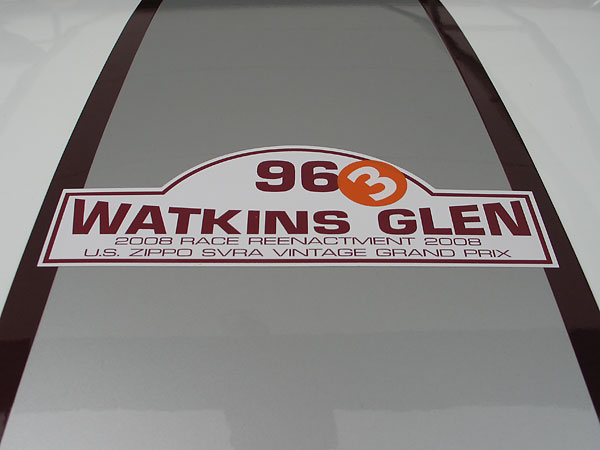
�
Watkins Glen: 2008 Zippo SVRA Vintage Grand Prix.
�
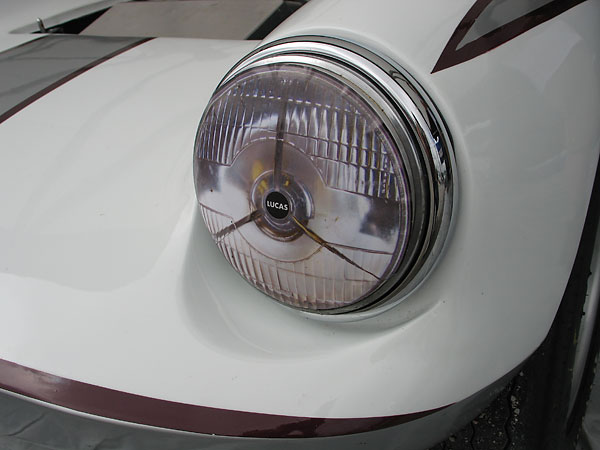
�
Lucas headlight decal.
�
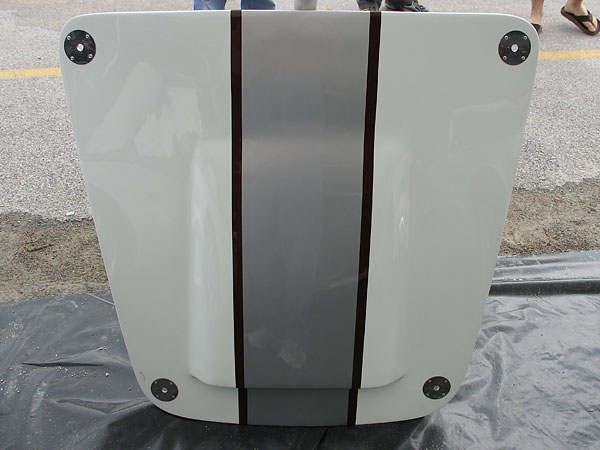
�
Bonnet.
�
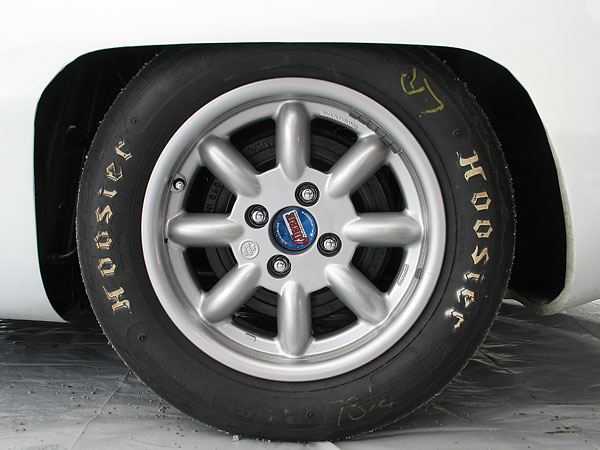
�
Compomotive 6J14 / Hoosier 205/60D14.
�
�
All photos shown here are from June 2009, when we viewed the car at The Heacock Classic Gold Cup at �
Virginia International Raceway, or from February 2009 when BritishV8 viewed the car at Abacus Racing in �
Virginia Beach, Virginia. All photos by Curtis Jacobson for BritishRaceCar.com, copyright 2009. �
All rights reserved.
�
| If you liked this article, you'll probably also enjoy these: | �|||||
 | �
Kent Prather '62 MG MGA | �
 | �
Bernard Bradpiece '63 Elva MkVII | �
 | �
Vic Schuster '65 Turner MkIII | �
| You're invited to discuss anything you've seen here on The British Racecar Motorsports Forum! | �|||||
�
Notice: all the articles and almost all the photos on BritishRacecar.com are by Curtis Jacobson.
�
(Photos that aren't by Curtis are explicitly credited.) Reproduction without prior written permission is prohibited.
�
Contact us to purchase images or reproduction permission. Higher resolution images are optionally available.
�

 �
�
